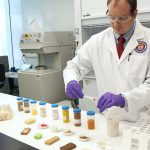
Photo above by Burst on Unsplash
Introduction
Following the introduction of mineral fertiliser, mechanisation and the industrialisation of the production process, digital agriculture brings the next major movement. It is part of the Fourth Industrial Revolution (4IR).
Digital agriculture refers to the use of agricultural technology (AgriTech) and data-driven innovations to predict outcomes and guide the producer through every phase of operations on the farm. There are many benefits:
- Digitising your fields enables you to tailor inputs (fertiliser, herbicides etc) accordingly. Yields are thus improved, and the more precise use of inputs dramatically reduces costs.
- There are obvious environmental benefits resulting from the judicious application of inputs like fertiliser, fuel, chemicals because of a new production system with its new tools.
- Livestock can be scanned and an eye kept on movement and behaviour. The captured data is analysed by artificial intelligence (AI), enabling the appropriate interventions to be made.
- The smarter use of inputs and decision-making made possible also helps the farmer deal with increasingly narrow margins.
- It provides help with labour issues, be this labour availability or reliability
- Digital agriculture helps with fluctuating and unpredictable weather patterns.
- There is better market access and biosecurity.
- It is hoped that the technological advances might be attractive to young people and draw them into the sector.
- As nearly every source on digital agriculture will mention, the aim of feeding the projected increase in planet population looks more attainable.
Some of the tools for digital agriculture are outlined in the following headings.
Contents
Contents
Agribots
Apps
Artificial intelligence (AI)
Augmented Reality
Autonomous machinery
Big data
Block chain
Drones
Global Positioning System (GPS)
Internet of things (IoT)
Satellites
Sensors
Software
Three Dimensional Printing (3D)
Virtual Reality
Smallholder farmer points of interest
International business environment
Local business environment
National strategy & government contact
Role players
Websites & publications
Agribots
Robots can automate tasks like planting, weeding and manufacturing.
Further reference:
- Kriel G. 2022, January 13. “Robot boosts blueberry picking efficiencies”. Farmer’s Weekly. Available at www.farmersweekly.co.za/crops/field-crops/robot-boosts-blueberry-picking-efficiencies
- Rose D., Hanheide M. & Pearson S. 2021, June 23. “Robot farmers could improve jobs and help fight climate change – if they’re developed responsibly”. The Conversation. Available at https://theconversation.com/robot-farmers-could-improve-jobs-and-help-fight-climate-change-if-theyre-developed-responsibly-162718
- Fresh Plaza. 2021, April 28.”Robotic harvester plucks an apple every 7 seconds”. Available at www.freshplaza.com/article/9316228/robotic-harvester-plucks-an-apple-every-7-seconds/
- Van Rooyen C. 2020 January 17. “‘n Robot wat skape kan skeer …” [a robot that can shear sheep]. Landbouweekblad. Available at www.netwerk24.com/landbou/Bedrywe/Tegnologie/n-robot-wat-skape-kan-skeer-20200117
- Paquette, D. 2019, February 17. “Farmworker vs Robot”. The Washington Post. Available at https://www.washingtonpost.com/news/national/wp/2019/02/17/feature/inside-the-race-to-replace-farmworkers-with-robots/
- Find the video “Robot Farm to Harvest 30,000 heads of lettuce daily” on Youtube.
Apps
A shortened form of “application software”, an app is a computer programme designed to run on cell phones and tablets. There are now billions of apps available including several thousand agriculture-related ones.
Some articles:
- Kriel G. 2020, September 3. “An app for every farming task”. Farmer’s Weekly. Available at www.farmersweekly.co.za/farm-basics/how-to-business/an-app-for-every-farming-task/
Artificial intelligence (AI)
Digital technologies are fundamental to artificial intelligence. AI looks across a farmer’s operations, analyses data – soil composition, weather, moisture, temperature etc – and provides insight on how to optimise resources and equipment.
AI can advise on matters like early treatment to combat mastitis in dairy cattle (a result of interpreting data from thermal imaging cameras) or let the owner know on the best time to sell cattle after measuring the weight and muscle mass of cattle (through 3D cameras). It can watch the movement of thousands of chickens and analyse behaviour to identify possible problems, or use microphones above pig pens to monitor conditions.
This degree of monitoring makes agricultural operations are more profitable.
Augmented reality
An example could be a pair of “smart” glasses used by feedlot producers to remotely attend livestock auction …
Autonomous machinery
Tractors being driven from a laptop is not new, but some tractor models do not even have a seat for a driver now! The Autonomous Farm Equipment Market size was valued at US$72.3 Billion in 2022, and is projected to reach a revised size of US$192.1 Billion by 2032 (Spherical Insights, 2023).
Some articles:
- Gagliordi, N. 2018, December 12. “How self-driving tractors, AI, and precision agriculture will save us from the impending food crisis”. Tech Republic. Available at www.techrepublic.com/article/how-self-driving-tractors-ai-and-precision-agriculture-will-save-us-from-the-impending-food-crisis/
- 2018, August 31. “Bear Flag Robotics’ New Autonomous Tractor”. Available at www.youtube.com/watch?v=4mEzr8HOlOE
- 2018, August 9. “Yes, you can build your own autonomous tractor”. Available at www.youtube.com/watch?v=Odgnn1aYjKI
Big data
Data has become a valuable global commodity. But it is much more than simply information: in expert hands, it is intelligence.
Already, analysts are finding ways to turn big data — the immense stocks of information collected in computers worldwide — into an invaluable resource for planning and decision-making. It is helping accelerate the development of robust responses to some of the most pressing challenges of our time: climate change/variability, food insecurity and malnutrition, and environmental degradation. It is transforming the world of genomics and crop breeding and revolutionizing disciplines from climate modelling to agronomy.
Source: https://blog.ciat.cgiar.org/cgiar-platform-for-big-data-in-agriculture/
Some articles:
- Botha L. 2020, October 4. “Is data the new soil in agri?” Farmer’s Weekly. Available at www.farmersweekly.co.za/agri-technology/farming-for-tomorrow/is-data-the-new-soil-in-agri/
- Phillips L. 2020, January 17. “Dealing with the data produced by precision farming”. Farmer’s Weekly. Available at www.farmersweekly.co.za/agri-technology/farming-for-tomorrow/dealing-with-the-data-produced-by-precision-farming
Block chain
Blockchain “has the potential to usher in an era of autonomous digital commerce” (Lemmer, 2019). According to the UN Food and Agriculture Organisation (FAO), blockchains have been applied to areas like (i) Overseeing farm inventory (ii) Managing land records (iii) Enhancing agricultural supply chains (iv) Fair pricing (v) Mobile remittance for small farmers (vi) AgTech IoT Optimisation (vii) Fair Pricing, and (viii) Managing and modernizing farm management software.
On its website, find FAO (and partners) documents which include:
- Emerging Opportunities for the Application of Blockchain in the Agri-food Industry
- E-agriculture in action: Blockchain for agriculture
- How can blockchain’s general architecture enhance trade facilitation in agricultural supply chains?
Some articles:
- Find the FAO page on blockchains at http://www.fao.org/e-agriculture/news/focus-blockchain-agriculture
- Reporter. 2019, November 28. “Blockchain, driven by IoT, can save food industry $31bn by 2024”. BizCommunity. Available at www.bizcommunity.com/Article/196/168/198420.html
Drones
See separate page.
Global Positioning System (GPS)
See “Precision farming” page.
Internet of things (IoT)
The Internet of Things (IoT) is tangible for today’s farmers. All the data, be it from sensor or satellite, feeds into cell phone apps or software and a communication between farm equipment (machines, implements, infrastructure etc) occurs. Every part knows where it stands in relation to the other parts. And so, for example, it is easier to prevent row overlap when running multiple machines at the same time.
Some articles:
- Rossier Z. 2021, September 6. “How the Internet of Things (IoT) is connecting rural farmers to the world”. 702. Available at www.702.co.za/articles/424621/how-the-internet-of-things-iot-is-connecting-rural-farmers-to-the-world
- Kriel G. 2021, August 29. “The evolution of power in SA’s agri machinery market”. Farmer’s Weekly. Available at www.farmersweekly.co.za/agri-technology/machinery-equipment/the-evolution-of-power-in-sas-agri-machinery-market
Satellites
See precision farming page.
The use of satellites has changed the world and how information is passed on. Apart from the bird’s-eye advantage, there is no need to roll out infrastructure in rural (and urban) areas which requires maintenance and which can go missing. The always-on status offers confidence.
Data from satellites is used to estimate crop yields, but can also indicate crop health and maturity. This allows for early warnings for crop failure and famine.
Land is mapped digitally and in very helpful details, without the services of cartographer required. Satellite information can be combined with data obtained from drones/UAVs and sensors to sharpen the accuracy and usefulness of the information.
This makes smart irrigation and precision farming possible.
Sensors
Sensors monitor and measure conditions and provide data, be it for soil or weather conditions, movement amongst livestock or even how full a distant water crib is. A crop may require more water or fertiliser in a particular part of the field, or a cow may spend less time sitting down because it is on heat and requires a bull, for example. A planter using AI from a sensor to understand the ground conditions and alter planting settings automatically is envisioned in the near future (Gagliordi, 2018).
Sensors are “the Digital Nervous System of the Internet of Things” (Purnell, 2016).
Some articles:
- Nturambirwe JFI & Opara U. 2020, January 28. “How sensors and big data can help cut food wastage”. The Conversation. Available at https://theconversation.com/how-sensors-and-big-data-can-help-cut-food-wastage-128563
Software
Various software is available for the farmer, ranging from financial programmes to administration and management programmes. These cover the different types of livestock, crops and functions on the farm. The latter includes irrigation scheduling, fertilisation, tank control within a cellar (wine), packhouse control, payroll software. Programmes can monitor weather elements, soil moisture, pests and diseases, vehicles and fuel consumption etc.
The advantages of software include:
- An efficient, tidy tool for record keeping
- less time spent on administration
- quick and easy query resolutions, and thus better decision-making
- analysis and summaries of costs and production and what still needs to be done
- better yields and quality
In addition to being an enhanced information and decision making tool for the farm, it also becomes an invaluable way of bridging the space between producer and market. Traceability – the requirement of being able to track the field or animal from where a product came – makes software crucial.
Many on-farm software programmes applicable to animal breeding are available for producers, combining the functionality of herd management with on-farm recording. Find details of livestock computer programme (Software) providers on the “Animal Improvement and breeders” page. Several companies offering inputs also supply accompanying software.
Three-dimensional printing (3D)
3D will be used to manufacture replacement parts for farm implements and vehicles, or, by utilising genetic research, to produce meat or other food products.
Some articles:
- Reuters. 2020, June 30. “Coming soon to a 3D printer near you: Plant-based steaks”. Eye Witness News. Available at https://ewn.co.za/2020/06/30/coming-soon-to-a-3d-printer-near-you-plant-based-steaks
Virtual reality
This includes computer-simulated images or environments. This can be useful in the training of farmworkers, for example (Lemmer, 2019).
Smallholder farmer points of interest
Some articles and points of interest:
- The app Hello Tractor, that connects tractor owners to farmers, could transform productivity and improve food security and incomes. See https://agra.org/news/africa-has-an-uber-opportunity-to-disrupt-farming-technology/
- Reporter. 2019, July 11. “How digital technologies can help Africa’s smallholder farmers”. The Conversation. Available at https://theconversation.com/how-digital-technologies-can-help-africas-smallholder-farmers-119952
- Ajit M, Berne D, De Beer J, Ballantyne P et al. 2018. Digital and Data-Driven Agriculture: Harnessing the Power of Data for Smallholders. Global Forum on Agricultural Research (GFAR); Global Open Data for Agriculture and Nutrition (GODAN); Technical Centre for Agricultural and Rural Cooperation (CTA). Available at www.gfar.net/documents/digital-and-data-driven-agriculture-harnessing-power-data-smallholders
- Malan, N. 2018, December 9. “The new agriculture and developing emerging farmers: Harnessing the Fourth Industrial Revolution”. Daily Maverick. Available at www.dailymaverick.co.za/article/2018-12-09-the-new-agriculture-and-developing-emerging-farmers-harnessing-the-fourth-industrial-revolution/
International business environment
Opportunity or threat? Digital agriculture is disruptive to the big industry manufacturers and their business model of the past 50-60 years (Blackmore, 2018). It is small start-up companies with no investment in the past that are driving the experimentation in new technology, specifically new machines.
Workers in all countries are likely to be negatively affected by the Fourth Industrial Revolution, and how countries and their workforces adapt to the changes in skills sets will increasingly influence national narratives (Hlatswayo, 2018; Ngcwangu, 2019).
Further reference:
- Find the Digital Agriculture page on the Food and Agriculture Organization (FAO) of the United Nations, www.fao.org/digital-agriculture/en/
- OECD. 2018. “New technologies and digitalisation are transforming agriculture and offering new opportunities to improve policy”. Available at www.oecd.org/agriculture/topics/technology-and-digital-agriculture/
- EY states that “As technical advancements in equipment and inputs slow, companies will need increasingly to compete on digital strategy”. See www.ey.com/Publication/vwLUAssets/EY-Performance-digital-agriculture/$File/EY-Performance-digital-agriculture.pdf
Some role players:
- Agrobot Robotic Harvesters http://agrobot.com/ Robotic strawberry harvesters (Watch “Agrobot” on YouTube)
- AgStack Foundation https://agstack.org
- Blue River Technology (John Deere) www.bluerivertechnology.com/
- Centre for the Fourth Industrial Revolution (C4IR) www.weforum.org/centre-for-the-fourth-industrial-revolution
- Take a look at the CGIAR Platform for Big Data in Agriculture at https://bigdata.cgiar.org
- Climate Corporation, https://climate.com, “Digital agriculture’s leading farm software platform”
- Digital Agriculture Services (Australia) https://digitalagricultureservices.com
- EOS DATA Analytics https://eos.com/industries/agriculture/
- FarmBeats www.microsoft.com/en-us/garage/wall-of-fame/farmbeats/ [Microsoft’s FarmBeats Program www.youtube.com/watch?v=KTvdjcU0lf8]
- FarmERP (India) www.farmerp.com
- Farmers Business Network (USA) www.fbn.com “an independent network of thousands of America’s most advanced farmers”
- FIRA – International Forum of Agricultural Robotics www.youtube.com/watch?v=l03kjzNjpWI&feature=youtu.be&t=13927
- See the Food and Agriculture Organisation (FAO) discussion regarding an International Digital Council for Food and Agriculture at www.fao.org/e-agriculture/international-digital-council-food-and-agriculture
- GoMicro www.gomicro.co
- Harper Adams University www.harper-adams.ac.uk
- Harvest Croo Robotics https://harvestcroo.com
- Peacock Technology www.peacocktechnology.com
- PlanetLabs www.planet.com
- RAVEN https://ravenind.com
- RocketFarm Robotics www.rocketfarm.no
- SwarmFarm Robotics (Australia) www.swarmfarm.com
- YARA www.yara.com/digital-farming/
Local business environment
For farmers
- They need to identify the area in which they can remain competitive in the 4IR environment. What are your core strengths? Your future business model for your farming operation should be based on these.
- Who can you partner with upstream and downstream?
- Farmers need to know how to analyse their captured data to operate more efficiently.
- Farmers need to know how to monetise business opportunities that arise from the digital agriculture technologies.
Agribusinesses
- Agricultural companies that supply inputs and services to producers will need to have procedures in place to systematically screen, evaluate and prioritise emerging technologies.
Department of Agriculture, Land Reform and Rural Development (DALRRD)
- DALRRD ought to begin an information campaign to inform farmers about upcoming technologies that will change how food is produced.
Source: Wessel Lemmer
National strategy and government contact
South Africa’s future development depends on how it masters the technologies of the Fourth Industrial Revolution (4IR). If it does not respond to the changing global environment the country can be left behind.
Further reference:
- Reporter. 2022, November 11. “SA forges ahead with 4IR strategy”. SA News. Available at www.sanews.gov.za/south-africa/sa-forges-ahead-4ir-strategy
- Lonzi S. 2022, June 11. “SA’s 4IR: Revolution or global peer pressure”. IOL. Available at www.iol.co.za/news/politics/opinion/sas-4ir-revolution-or-global-peer-pressure-0f6a06ad-4d14-4ed8-8ad7-d98cbf460a38
- Andreoni A. & Avenyo E. 2021, December 2. “South Africa is failing to ride the digital revolution wave. What it needs to do”. The Conversation. Available at https://theconversation.com/south-africa-is-failing-to-ride-the-digital-revolution-wave-what-it-needs-to-do-171515
Role players
Further reference:
Associations
- Find the associations listed on pages like “Tractors, combines and balers”, “Irrigation” and “Soils”.
Training and research
- Training and upskilling for digital agriculture is crucial. Mostly the companies selling machines and technology provide training for clients and their employees. The demand for general farm workers will shrink as agricultural processes become more automated and digitalised, and the matching skills will be in demand (Kriel, 2019).
Companies
- Companies providing inputs (e.g. irrigation, grain storage and handling) also supply accompanying tools or apps for digital agriculture. Find their details on the relevant pages on this website.
- Many on-farm software programmes applicable to animal breeding are available for producers, combining the functionality of herd management with on-farm recording. Find details of livestock computer programme (Software) providers on the “Animal Improvement and breeders” page.
Websites and publications
See the earlier references on this page.
- Brini M. 2023 September. The Digital Transformation of Food Systems Artificial Intelligence and other digital opportunities in the modern Food Systems. ResearchGate. Available at www.researchgate.net/publication/373718966_The_Digital_Transformation_of_Food_Systems_Artificial_Intelligence_and_other_digital_opportunities_in_the_modern_Food_Systems
- Brini M. 2023. Implementing Digital Agriculture Step-by-step. ResearchGate. Available at www.researchgate.net/publication/369747012_Implementing_Digital_Agriculture_Step-by-step
- FAO. 2022. Status of digital agriculture in 47 sub-Saharan African countries. Available at www.fao.org/documents/card/en/c/cb7943en
- Agriculture Victoria. 2021. What is digital agriculture? Available at https://agriculture.vic.gov.au/farm-management/agtech/what-is-digital-agriculture
- Find the African Development Bank (AfDB)‘s “Digital Agriculture Profile – South Africa” (2021, April 26) at www.afdb.org/en/documents/digital-agriculture-profile-south-africa
- Jacobs AJ, van Tol JJ & Du Preez CC. 2019. “Farmers perceptions of precision agriculture and the role of agricultural extension: a case study of crop farming in the Schweizer-Reneke region, South Africa”. South African Journal of Agricultural Extension 46(2). http://dx.doi.org/10.17159/2413-3221/2018/v46n2a484
- View the Trade Machine infographic on the 4th Agricultural Revolution at http://trademachines.com/info/agriculture-4-0/.
- Read the USAID page on Digital Agriculture at www.usaid.gov/digitalag
- The document The Future of the Western Cape Agricultural Sector in the Context of the 4th Industrial Revolution (2017) explores agriculture in each of the industrial revolutions before its analysis of the fourth. Find the document at www.elsenburg.com/sites/default/files/24.%204IR%20%20AGRICULTURE%20LITERATURE%20REVIEW%20%281%29.pdf.
Videos
- There are many videos on YouTube!
Some articles
- Read Agribook blogs like “Advanced food processing technologies could make the food industry more sustainable”, “Tapping into technology to drive the sustainability of SA’s agriculture industry“, “Investment in technology vital to boost agricultural output and exports“, “Can technology solve the biggest challenges to your farm?“, “Digitally transforming agriculture across distances” and “Technology is ‘disrupting’ agriculture and will bring benefits to 21st century farmers, says Standard Bank.“
- Collen C. 2023, August 1. “Integrated digitisation crucial for agriculture”. Fruit Net. Available at www.fruitnet.com/main-navigation/integrated-digitisation-crucial-for-agriculture/255288.article
- Reporter. 2023, July. “Earth observation and disruptive economics”. Harvest SA. Available at https://harvestsa.co.za/magazine/65/index.html#p=28
- Platt J. 2023, July 2. “Five devices set to revolutionise agriculture”. Farmer’s Weekly. Available at www.farmersweekly.co.za/agri-technology/machinery-and-equipment/five-devices-set-to-revolutionise-agriculture/
- Bell L-A. 2022, September. “12 Digital Agricultural Tools”. Agriprobe 19 (3). Available at www.elsenburg.com/wp-content/uploads/2022/09/AgriProbe-Vol-19-No-3-2022-Interactive-200dpi.pdf
- 2022, June 8. “South Africa: Livestream broadcasts cut travel costs and lower a farm’s carbon footprint”. FreshPlaza. Available at www.freshplaza.com/article/9433884/south-africa-livestream-broadcasts-cut-travel-costs-and-lower-a-farm-s-carbon-footprint/
- Kriel G. 2021, August 29. “The evolution of power in SA’s agri machinery market”. Farmer’s Weekly. Available at www.farmersweekly.co.za/agri-technology/machinery-equipment/the-evolution-of-power-in-sas-agri-machinery-market/
- Rose D. & C-A. Chivers. 2020, September 14. “The fourth agricultural revolution is coming – but who will really benefit?” The Conversation. Available at https://theconversation.com/the-fourth-agricultural-revolution-is-coming-but-who-will-really-benefit-145810
- Kriel G. 2019, August 3. “High demand for smart machine operators”. Farmer’s Weekly. Available at www.farmersweekly.co.za/agri-technology/machinery-equipment/high-demand-for-smart-machine-operators/
General 4IR
- Castel-Branco R. & Dawson H. 2022, June 8. “The Fourth Industrial Revolution: a seductive idea requiring critical engagement”. The Conversation. Available at https://theconversation.com/the-fourth-industrial-revolution-a-seductive-idea-requiring-critical-engagement-184475
- Naicker B. 2021, February 26. “BLOCKCHAIN TECHNOLOGY: Bridging the digital skills gap is key to addressing unemployment”. Business Report. Available at www.iol.co.za/business-report/budget/blockchain-technology-bridging-the-digital-skills-gap-is-key-to-addressing-unemployment-128f4f48-76fc-404f-95bc-b589a2c8a2a2
- Gillwald A. 2019, October 3. “South Africa must harness technology in a way that helps fix its problems”. The Conversation. Available at https://theconversation.com/south-africa-must-harness-technology-in-a-way-that-helps-fix-its-problems-121191
- Roberts B, Struwig J, Bohler-Muller N & Gordon S. 2019, July 17. “South Africans are upbeat about new technologies but worried about jobs”. The Conversation. Available at https://theconversation.com/south-africans-are-upbeat-about-new-technologies-but-worried-about-jobs-120358



Share this article







